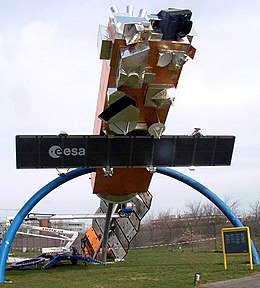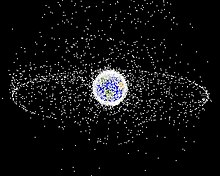Envisat
 Model of Envisat | |
| Mission type | Earth observation |
|---|---|
| Operator | ESA |
| COSPAR ID | 2002-009A |
| SATCATno. | 27386 |
| Website | envisat |
| Mission duration | Planned: 5 years Final: 10 years, 1 month, 6 days |
| Spacecraft properties | |
| Manufacturer | Astrium |
| Launch mass | 8,211 kg (18,102 lb) |
| Dimensions | 26 × 10 × 5 m (85 × 33 × 16 ft) |
| Power | 6,500 watts |
| Start of mission | |
| Launch date | 1 March 2002, 01:07:59UTC |
| Rocket | Ariane 5GV-145 |
| Launch site | KourouELA-3 |
| Contractor | Arianespace |
| End of mission | |
| Disposal | None |
| Declared | 9 May 2012 |
| Last contact | 8 April 2012 (spacecraft failure) |
| Decay date | ~150 years |
| Orbital parameters | |
| Reference system | Geocentric |
| Regime | Polarlow Earth |
| Semi-major axis | 7,144.9 km (4,439.6 mi) |
| Eccentricity | 0.00042 |
| Perigee altitude | 772 km (480 mi) |
| Apogee altitude | 774 km (481 mi) |
| Inclination | 98.40 degrees |
| Period | 100.16 minutes |
| Repeat interval | 35 days |
| Epoch | 15 December 2013, 03:07:00 UTC[1] |
| Instruments | |
Envisat( "Environmental Satellite") is a largeEarth-observing satellitewhich has been inactive since 2012. It is still in orbit and considered space debris. Operated by theEuropean Space Agency(ESA), it was the world's largest civilian Earth observation satellite.[2]
It was launched on 1 March 2002 aboard anAriane 5from theGuyana Space CentreinKourou,French Guiana,into aSun synchronouspolar orbitat an altitude of 790 ± 10 km. ItorbitstheEarthin about 101 minutes, with a repeat cycle of 35 days. After losing contact with the satellite on 8 April 2012, ESA formally announced the end of Envisat's mission on 9 May 2012.[3]
Envisat cost 2.3 billion Euro (including 300 million Euro for 5 years of operations) to develop and launch.[4]The mission has been replaced by theSentinelseries of satellites. The first of these,Sentinel 1,has taken over the radar duties of Envisat since its launch in 2014.
Mission[edit]
Envisat was launched as anEarth observation satellite.Its objective was to support the continuity ofEuropean Remote-Sensing Satellitemissions, providing additional observations to improve environmental studies.
To accomplish the global and regional objectives of the mission, numerous scientific disciplines used the data acquired from the sensors on the satellite to studyatmospheric chemistry,ozone depletion,biological oceanography,ocean temperature and colour,wind waves,hydrology(humidity,floods), agriculture andarboriculture,natural hazards,digital elevation modelling(usinginterferometry), monitoring of maritime traffic,atmospheric dispersion modelling(pollution),cartographyandsnowandice.
Specifications[edit]
- Dimensions
26 m (85 ft) × 10 m (33 ft) × 5 m (16 ft) in orbit with the solar array deployed.[5]
- Mass
8,211 kg (18,102 lb), including 319 kg (703 lb) of fuel and a 2,118 kg (4,669 lb) instrument payload.[6]
- Power
Solar arraywith a total load of 3560W.
Instruments[edit]

This sectionneeds additional citations forverification.(August 2020) |
Envisat carries an array of nine Earth-observation instruments that gathered information about the Earth (land,water,ice,andatmosphere) using a variety of measurement principles. A tenth instrument, DORIS, providedguidance and control.Several of the instruments were advanced versions of instruments that were flown on the earlierERS-1andERS 2missions and other satellites.
MWR[edit]
MWR (MicrowaveRadiometer) was designed for measuringwater vapourin theatmosphere.
AATSR[edit]
AATSR (Advanced Along Track ScanningRadiometer) can measure theseasurface temperature in thevisibleandinfrared spectra.It is the successor of ATSR1 and ATSR2, payloads ofERS 1andERS 2.AATSR can measure Earth's surface temperature to a precision of 0.3 K (0.54 °F), forclimate research.Among the secondary objectives of AATSR is the observation of environmental parameters such as water content, biomass, and vegetal health and growth.
MIPAS[edit]
MIPAS (MichelsonInterferometerfor PassiveAtmospheric Sounding) is aFourier transforminginfrared spectrometer which provides pressure and temperature profiles, and profiles of trace gases nitrogen dioxide (NO
2), nitrous oxide (N
2O), methane (CH
4), nitric acid (HNO
3), ozone (O
3), and water (H
2O) in thestratosphere.The instrument functions with high spectral resolution in an extended spectral band, which allows coverage across the Earth in all seasons and at equal quality night and day. MIPAS has a vertical resolution of 3 to 5 km (2 to 3 mi) depending on altitude (the larger at the level of the upper stratosphere).
MERIS[edit]
MERIS (MEdium Resolution ImagingSpectrometer) measures the reflectance of the Earth (surface and atmosphere) in the solar spectral range (390 to 1040nm) and transmits 15 spectral bands back to theground segment.MERIS was built at theCannes Mandelieu Space Center.
SCIAMACHY[edit]
SCIAMACHY (SCanning Imaging Absorption spectroMeter for Atmospheric CHartographY) compares light coming from the sun to light reflected by the Earth, which provides information on the atmosphere through which the Earth-reflected light has passed.
SCIAMACHY is an image spectrometer with the principal objective of mapping the concentration of trace gases and aerosols in the troposphere and stratosphere. Rays of sunlight that are reflected transmitted, backscattered and reflected by the atmosphere are captured at a high spectral resolution (0.2 to 0.5 nm) for wavelengths between 240 and 1700 nm, and in certain spectra between 2,000 and 2,400 nm. Its high spectral resolution over a wide range of wavelengths can detect many trace gases even in tiny concentrations. The wavelengths captured also allow effective detection of aerosols and clouds. SCIAMACHY uses 3 different targeting modes: to the nadir (against the sun), to the limbus (through the atmospheric corona), and during solar or lunar eclipses. SCIAMACHY was built by Netherlands and Germany atTNO/TPD,SRONandAirbus Defence and SpaceNetherlands.[7]
RA-2[edit]
RA-2 (RadarAltimeter2) is a dual-frequencyNadirpointing Radar operating in theKubandandS bands,it is used to defineoceantopography,map/monitorsea iceand measure land heights.
Mean sea level measurements from Envisat are continuously graphed at the Centre National d'Etudes Spatiales web site, on the Aviso page.
ASAR[edit]
ASAR (Advanced Synthetic Aperture Radar) operates in theC bandin a wide variety of modes. It can detect changes in surface heights with sub-millimeterprecision. It served as a data link forERS 1andERS 2,providing numerous functions such as observations of differentpolarities of lightor combining different polarities, angles of incidence and spatial resolutions.
| Mode | Id | Polarisation | Incidence | Resolution | Swath |
|---|---|---|---|---|---|
| Alternating polarisation | AP | HH/VV, HH/HV, VV/VH | 15–45° | 30–150 m | 58–110 km |
| Image | IM | HH, VV | 15–45° | 30–150 m | 58–110 km |
| Wave | WV | HH, VV | 400 m | 5 km × 5 km | |
| Suivi global (ScanSAR) | GM | HH, VV | 1000 m | 405 km | |
| Wide Swath (ScanSAR) | WS | HH, VV | 150 m | 405 km |
These different types of raw data can be given several levels of treatment (suffixed to the ID of the acquisition mode: IMP, APS, and so on):
- RAW (raw data, or "Level 0" ), which contains all the information necessary to create images.
- S (complex data, "Single Look Complex" ), images in complex numeric form, the real and imaginary parts of the output of the compression algorithm
- P (precision image), amplified image with constant pixel width (12.5 m for IMP)
- M (medium precision image), amplified radiometry image with a resolution greater than P
- G (geocoded image), amplified image to which simple geographical transforms have been applied to show relief.
Data capture in WV mode is unusual in that they constitute a series of 5 km × 5 km spaced at 100 km.
DORIS[edit]
DORIS (DopplerOrbitography and Radiopositioning Integrated by Satellite) determines the satellite's orbit to within 10 cm (4 in).
GOMOS[edit]
GOMOS (GlobalOzoneMonitoring by Occultation ofStars) looks at stars as they descend through the Earth's atmosphere and change colour, allowing measurement ofgasessuch as ozone (O
3), including their vertical distribution.
GOMOS uses the principle ofoccultation.Its sensors detect light from a star traversing the Earth's atmosphere and measures the depletion of that light by trace gases nitrogen dioxide (NO
2), nitrogen trioxide, (NO
3),OClO), ozone (O
3) and aerosols present between about 20 to 80 km (12 to 50 mi) altitude. It has a resolution of 3 km (1.9 mi).
Loss of contact[edit]
ESAannounced on 12 April 2012 that they lost contact with Envisat on Sunday, 8 April 2012, after 10 years of service, exceeding the initially planned life span by 5 years. The spacecraft was still in a stable orbit, but attempts to contact it were unsuccessful.[8][9]Ground-based radar and the FrenchPleiadesEarth probe were used to image the silent Envisat and look for damage.[10]ESA formally announced the end of Envisat's mission on 9 May 2012.[3]
Envisat was launched in 2002 and it operated five years beyond its planned mission lifetime, delivering over apetabyteof data.[3]ESA was expecting to turn off the spacecraft in 2014. [11]
Space safety[edit]

Envisat poses a hazard because of the risk of collisions withspace debris.Given its orbit and its area-to-mass ratio, it will take about 150 years for the satellite to be gradually pulled into the Earth's atmosphere.[12]Envisat is currently orbiting in an environment where two catalogued space debris objects can be expected to pass within about 200 m (660 ft) of it every year, which would likely trigger the need for a manoeuvre to avoid a possible collision.[13]A collision between a satellite the size of Envisat and an object as small as 10 kg could produce a very large cloud of debris, initiating a self-sustaining chain-reaction of collisions and fragmentation with production of new debris, a phenomenon known as theKessler Syndrome.[13]
Envisat was a candidate for a mission to remove it from orbit, callede.Deorbit.The spacecraft sent to bring down Envisat would itself need to have a mass of approximately 1.6 tonnes.[14]
See also[edit]
References[edit]
- ^"ENVISAT Satellite details 2002-009A NORAD 27386".N2YO.15 December 2013.Retrieved15 December2013.
- ^EarthNet Online
- ^abc"ESA declares end of mission for Envisat".ESA. 9 May 2012.
- ^European Space Agency web-site
- ^"EnviSat (Environmental Satellite)".eoPortal.
- ^Envisat – Overall configuration
- ^"I - Sciamachy".
- ^"Breaking News | Flagship Envisat satellite stops communicating".Spaceflight Now.Retrieved21 April2012.
- ^"ESA Portal – Envisat services interrupted".Esa.int.Retrieved21 April2012.
- ^Huge, Mysteriously Silent Satellite Spotted by Another SpacecraftSpace article, 20 April 2012
- ^Contact lost with flagship Envisat spacecraft12 April 2012.
- ^"Envisat To Pose Big Orbital Debris Threat for 150 Years, Experts Say."SpaceNews.Retrieved: 27 September 2015.
- ^abGini, Andrea (25 April 2012)."Don Kessler on Envisat and the Kessler Syndrome".Space Safety Magazine.Retrieved9 May2012.
- ^"e.Deorbit Symposium".ESA. 6 May 2014. Archived fromthe originalon 1 July 2015.Retrieved2 June2015.
External links[edit]
- Envisat homepage at ESA
- Envisat operations page at ESA
- Miravi– Meris Image Rapid Visualization. MIRAVI shows the gallery of images generated on the Level0 (raw data) Meris Full Resolution (300m) products, few seconds after their availability.
- SRRS– Satellite Rapid Response System. Like MIRAVI but including also ASAR, MERIS Full and Reduced Resolution and ALOS AVNIR2 images.
- Earth Snapshot– Web Portal dedicated to Earth Observation. Includes commented satellite images, information on storms, hurricanes, fires and meteorological phenomena.
- ESA SNAP Toolboxfor viewing, calibrating and analyzing Envisat ASAR Level 1 data and higher
- Four years on, Envisat hailed for its contribution to Earth sciencePhysorg (2006-02-28)
- ESA Envisat DDS (Data Dissemination System)
- gcs Global Communication & Services– Manufacturer of the Envisat DDS Commercial Receiver Kit forENVIHAM Home Users
- Dossier Envisat: 10 years of climate and environmental research at Astrium
- Envisat article on eoPortal by ESA
